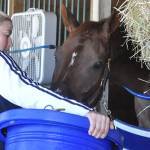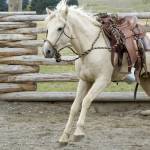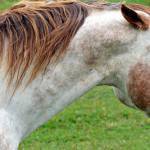Question
I have an easy keeper of mixed breeding (complete with a cresty neck and fat pads) that I use for endurance competitions. I ride two or three times a week, and she maintains her weight on limited pasture, about 1.5 lb (0.7 kg) concentrate, 1 cup whole flax seeds, balancer pellet, magnesium oxide, and probiotics. My first three questions: (1) does a ration balancer contain too much protein for an endurance horse; (2) does this diet provide enough fuel for her to get through a competition ride (I add beet pulp, alfalfa (lucerne) cubes, electrolytes, and calcium carbonate powder before a competition ride); and (3) should I add concentrates or oats before or on competition day to increase energy? Next concern: (4) is the calcium carbonate I'm adding to her electrolytes beneficial or harmful? I'm worried about skewing the calcium and phosphorus ratio. Other endurance riders have suggested using calcium gluconate instead of calcium carbonate, stating that it will help prevent muscle cramping since my mare is of a heavier-muscled breed than the typical endurance horse of Arabian breeding. She has no history of cramps, but this is her first season. She does show signs of fatigue and delayed recovery after competing in high humidity. I give her the calcium as a gastrointestinal buffer, as she once showed symptoms of gastric ulcers. A couple of riders suggested using branched-chain amino acids (BCAAs). Is this a good idea?
Answer
In regard to the protein content of the balancer pellet, feeding the recommended amount will not provide too much protein to your mare. The mare’s current diet is providing enough calories, but it may not be providing the best energy substrates for endurance exercise. When you step up your training program to 50-mile rides, her current weight should not be an issue and you will probably see significant weight loss.
I would recommend adding more fat to her diet. You can do this by increasing the amount of whole flax seeds fed per day to 1.5 cups or by adding vegetable oil (0.25 cup) as soy or canola oil to her ration balancer. You can continue adding alfalfa cubes and beet pulp before a competition ride in addition to the added fat. Horses require an adaptation period to properly utilize fat in their diets for exercise, so start feeding fat 2-4 weeks before your next competition.
Another strategy for providing energy during competition would be to offer starch in the form of oats at each stop (1 to 2 handfuls) and introducing this into her diet the week prior to competition along with the beet pulp and alfalfa. As the spring grass slows in growth, you may want to consider providing her with the soaked beet pulp and/or alfalfa on a more regular basis to encourage water intake, helping to keep her hydrated and providing a source of fermentable fiber. The additional alfalfa can also help provide some protection to the stomach by acting as a buffer. An alternative option would be to include a digestive supplement such as RiteTrac*, as this provides total digestive tract support as it contains gastric buffers and coating agents as well as EquiShure, a time-released hindgut buffer that keeps acidosis from developing.
Calcium gluconate is a more bioavailable source of calcium compared to calcium carbonate. Because it is absorbed more quickly, calcium gluconate is often used to treat thumps. I would recommend feeding calcium gluconate if you are feeding it to boost calcium intake, but I would continue feeding calcium carbonate to buffer stomach acid.
Your current electrolyte program is adequate; however, during 50-mile rides and when competing in hot, humid conditions, it would be beneficial to offer a full dose at stops from the middle of the ride to the end. To help minimize stomach irritation, you could mix your electrolyte with RiteTrac and offer this at the end of the rest stop once she has eaten.
KER offers an electrolyte called Restore SR (Restore in Australia), which is sugar-free and includes a slow-release form of sodium, allowing greater utilization of the electrolyte. Because you are feeding magnesium oxide daily, you could also add this to your electrolyte mixture during competition. I also recommend Preserve PS (Preserve in Australia), an antioxidant supplement containing selenium, natural-source vitamin E, vitamin C, and magnesium to support healthy muscle function and recovery. Including this supplement increases selenium intake. The current diet supplies adequate selenium but not enough to meet KER recommendations.
Supplementation with BCAAs (leucine, isoleucine, and valine) has been advocated as a strategy to improve performance; however, the mechanism and efficacy is undetermined and contradictory evidence has been reported in studies. There may be some benefit to providing BCAAs during the recovery period. If you are to move up to 100-mile rides, then offering BCAAs towards the end of a ride can help provide energy for the horse. As with proteins and nonbranched chain amino acids, when selecting a BCAA supplement all three amino acids need to be present in the correct ratio to have maximum benefit.
*RiteTrac is not available in Australia and New Zealand. Please contact KER Australia for options on managing digestive conditions in these areas.








